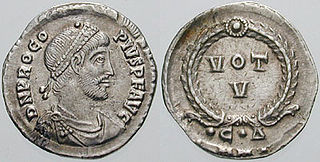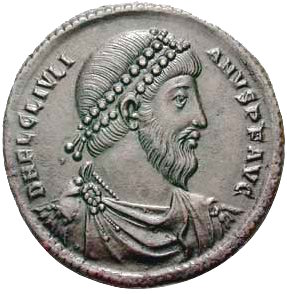The 310s decade ran from January 1, 310, to December 31, 319.
The 320s decade ran from January 1, 320, to December 31, 329.
The 490s decade ran from January 1, 490, to December 31, 499.
The 270s decade ran from January 1, 270, to December 31, 279.
The 390s decade ran from January 1, 390 to December 31, 399
The 410s decade ran from January 1, 410, to December 31, 419.
The 360s decade ran from January 1, 360, to December 31, 369.

Year 496 (CDXCVI) was a leap year starting on Monday of the Julian calendar. In the Roman Empire, it was known as the Year of the Consulship of Paulus without colleague. The denomination 496 for this year has been used since the early medieval period, when the Anno Domini calendar era became the prevalent method in Europe for naming years.
The 350s decade ran from January 1, 350, to December 31, 359.
The 370s decade ran from January 1, 370, to December 31, 379.
The 250s was a decade that ran from January 1, 250, to December 31, 259.
The 260s decade ran from January 1, 260, to December 31, 269.

Year 355 (CCCLV) was a common year starting on Sunday of the Julian calendar. At the time, it was known as the Year of the Consulship of Arbitio and Maesius. The denomination 355 for this year has been used since the early medieval period, when the Anno Domini calendar era became the prevalent method in Europe for naming years.

Year 260 (CCLX) was a leap year starting on Sunday of the Julian calendar. At the time, it was known as the Year of the Consulship of Saecularis and Donatus. The denomination 260 for this year has been used since the early medieval period, when the Anno Domini calendar era became the prevalent method in Europe for naming years.
Year 367 (CCCLXVII) was a common year starting on Monday of the Julian calendar. At the time, it was known as the Year of the Consulship of Lupicinus and Iovanus. The denomination 367 for this year has been used since the early medieval period, when the Anno Domini calendar era became the prevalent method in Europe for naming years.

Year 365 (CCCLXV) was a common year starting on Saturday of the Julian calendar. At the time, it was known in the West as the Year of the Consulship of Augustus and Valens. The denomination 365 for this year has been used since the early medieval period, when the Anno Domini calendar era became the prevalent method in Europe for naming years.

Year 361 (CCCLXI) was a common year starting on Monday of the Julian calendar. At the time, it was known as the Year of the Consulship of Taurus and Florentius. The denomination 361 for this year has been used since the early medieval period, when the Anno Domini calendar era became the prevalent method in Europe for naming years.
Pope Liberius was the bishop of Rome from 17 May 352 until his death. According to the Catalogus Liberianus, he was consecrated on 22 May as the successor to Julius I. He is not mentioned as a saint in the Roman Martyrology. That makes him the earliest pontiff not to be venerated as a saint in the Catholic Church and, along with Anastasius II, one of only two popes to be omitted from Catholic sainthood in the first 500 years of church history.
Serenianus was an officer of the Roman Empire, involved in the death of Caesar Constantius Gallus and in the usurpation of Procopius.
Marcellus was an officer of the Roman Empire, supporter of usurper Procopius and briefly an usurper himself.







